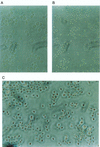Horizontal transfer of genetic material among Saccharomyces yeasts
- PMID: 10515941
- PMCID: PMC103786
- DOI: 10.1128/JB.181.20.6488-6496.1999
Horizontal transfer of genetic material among Saccharomyces yeasts
Abstract
The genus Saccharomyces consists of several species divided into the sensu stricto and the sensu lato groups. The genomes of these species differ in the number and organization of nuclear chromosomes and in the size and organization of mitochondrial DNA (mtDNA). In the present experiments we examined whether these yeasts can exchange DNA and thereby create novel combinations of genetic material. Several putative haploid, heterothallic yeast strains were isolated from different Saccharomyces species. All of these strains secreted an a- or alpha-like pheromone recognized by S. cerevisiae tester strains. When interspecific crosses were performed by mass mating between these strains, hybrid zygotes were often detected. In general, the less related the two parental species were, the fewer hybrids they gave. For some crosses, viable hybrids could be obtained by selection on minimal medium and their nuclear chromosomes and mtDNA were examined. Often the frequency of viable hybrids was very low. Sometimes putative hybrids could not be propagated at all. In the case of sensu stricto yeasts, stable viable hybrids were obtained. These contained both parental sets of chromosomes but mtDNA from only one parent. In the case of sensu lato hybrids, during genetic stabilization one set of the parental chromosomes was partially or completely lost and the stable mtDNA originated from the same parent as the majority of the nuclear chromosomes. Apparently, the interspecific hybrid genome was genetically more or less stable when the genetic material originated from phylogenetically relatively closely related parents; both sets of nuclear genetic material could be transmitted and preserved in the progeny. In the case of more distantly related parents, only one parental set, and perhaps some fragments of the other one, could be found in genetically stabilized hybrid lines. The results obtained indicate that Saccharomyces yeasts have a potential to exchange genetic material. If Saccharomyces isolates could mate freely in nature, horizontal transfer of genetic material could have occurred during the evolution of modern yeast species.
Figures



References
-
- Barker E R, Miller M W. Some properties of Saccharomyces kluyveri. Antonie van Leeuwenhoek. 1969;35:159–171. - PubMed
-
- Barnett J A. The taxonomy of the genus Saccharomyces Meyen ex Reess: a short review for non-taxonomists. Yeasts. 1992;8:1–23. - PubMed
-
- de Zamaroczy M, Bernardi G. Sequence organization of the mitochondrial genome of yeast—a review. Gene. 1985;37:1–17. - PubMed
-
- Goffeau A, Barrell B G, Bussey H, Davis R W, Dujon B, Feldmann H, Galibert F, Hoheisel J D, Jacq C, Johnston M, Louis E J, Mewes H W, Murakami Y, Philippsen P, Tettelin H, Oliver S G. Life with 6000 genes. Science. 1996;274:546–567. - PubMed
Publication types
MeSH terms
Substances
LinkOut - more resources
Full Text Sources
Other Literature Sources
Molecular Biology Databases

